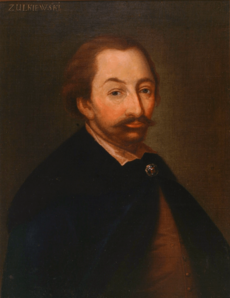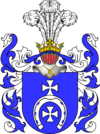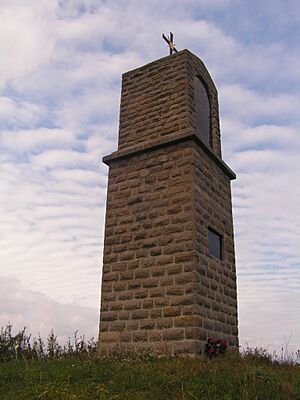Stanisław Żółkiewski facts for kids
Quick facts for kids
Hetman
Stanisław Żółkiewski |
|
|---|---|
  |
|
| Coat of arms | Lubicz |
| Full name |
Stanisław Żółkiewski herbu Lubicz
|
| Born | 1547 Turynka near Lwów, Kingdom of Poland |
| Died | 7 October 1620 Battle of Cecora near Iaşi, Ottoman Empire |
| Family | Żółkiewski |
| Consort | Regina Herburt h. Herburt |
| Issue | Jan Żółkiewski Katarzyna Żółkiewska Zofia Żółkiewska |
| Father | Stanisław Żółkiewski |
| Mother | Zofia Lipska h. Korczak |
Stanisław Żółkiewski (born in 1547, died October 7, 1620) was a famous Polish nobleman and military leader. He was a very important person in the Polish–Lithuanian Commonwealth, a large country that existed in Central and Eastern Europe. Żółkiewski held many high positions, including being a top military commander called a Hetman, and later the Grand Chancellor of the Polish Crown.
He led the Commonwealth army in many battles. He fought against powerful enemies like Sweden, Russia, the Ottoman Empire, and the Tatars. One of his most famous victories was in 1610 at the Battle of Klushino. There, his forces defeated a combined Russian and Swedish army. This victory allowed the Poles to take control of Moscow for a while.
Żółkiewski was known for his bravery. He died heroically in 1620 during the Battle of Cecora against the Ottoman Turks. He refused to leave his soldiers, even when they were losing. He is remembered as one of the greatest military commanders in the history of the Polish–Lithuanian Commonwealth.
Contents
Life of Stanisław Żółkiewski
Early Years and Learning
Stanisław Żółkiewski was born in 1547 in a village called Turynka. This village was then part of the Polish–Lithuanian Commonwealth. Today, it is in western Ukraine. His father was also named Stanisław Żółkiewski and was an important official.
Stanisław went to a school in Lwów (now Lviv, Ukraine). Unlike many young noblemen of his time, he did not go to a university or travel much abroad. However, he loved to learn on his own. He was especially interested in history and reading about past events. In 1566, he started working for King Sigismund II Augustus. He became an assistant to the king's secretary, Jan Zamoyski. This job helped him learn a lot about how the country was run. He also learned about ideas for making the army better.
First Military Experiences
Żółkiewski gained his first experience as a soldier under King Stefan Batory. He fought in a conflict called the Danzig rebellion. He commanded a unit of Polish hussars, who were famous armored cavalry. He also took part in King Batory's campaigns in Livonia. He fought in important battles and sieges, like the Siege of Pskov.
After these wars, Żółkiewski stayed friends with the powerful Zamoyski family. In 1584, he captured a nobleman named Samuel Zborowski. This event caused a lot of arguments and discussions in the Polish parliament.
In 1588, there was a conflict over who would be the next Polish king. Żółkiewski supported Sigismund III Vasa. He led the right side of the army in the Battle of Byczyna. During this battle, he was wounded in the knee. This injury made him limp for the rest of his life. Because of his bravery in the battle, he was given the title of Field Crown Hetman. This was a very high military rank.
Leading the Army
Soon after becoming a Hetman, Żółkiewski was sent to Ukraine. His job was to stop attacks from the Tatars, who were raiding the area. In 1590, he became the castellan of Lwów. This meant he was in charge of the city's defense. He asked for more soldiers to fight the Tatars, but his requests were not always granted.
In 1595, Żółkiewski fought in Moldova. He took part in the Battle of Cecora near the Prut river. The next year, he defeated a large uprising by the Cossacks led by Severyn Nalivaiko. Żółkiewski often tried to make peace with the Cossacks. He promised fair treatment to Nalivaiko and other leaders when they surrendered. However, Nalivaiko was later executed, and this made relations between Poles and Cossacks much worse. In 1600, Żółkiewski returned to Moldova and won another battle at Bukowo.
From 1601, Żółkiewski fought in the north, in Livonia, during a war against Sweden. He successfully captured several important towns like Wolmar and Fellin. He also led Polish forces to victory at the Battle of Reval. This led to the Swedes giving up at the siege of Biały Kamień. Żółkiewski became ill during this campaign and had to let another commander take over.
In 1606, Żółkiewski went back to Ukraine. He defeated the Tatars at the Battle of Udycz. Later that year, he decided to support the king during a rebellion by some Polish nobles. This was a difficult choice for him. He was related to some of the rebels and understood their reasons. In the Battle of Guzów, he commanded part of the king's army. Even though he supported the king, he did not get the highest military title he wanted. However, he was made the voivode of Kiev, which was an important administrative role.
War with Russia and Final Years
In 1609, Żółkiewski took part in a war against Russia. He supported the idea of Prince Władysław IV Vasa becoming the Tsar of Russia. He also hoped for a closer union between the Commonwealth and Russia. In 1610, he won a very important victory at the Battle of Klushino. This battle was against combined Russian and Swedish forces. After this success, Żółkiewski's army took control of Moscow. He even captured the Russian Tsar, Vasiliy Shuisky, and his brothers.
After returning from Russia, Żółkiewski wrote his memoirs. These writings, published in 1612, talked about the war. He also became a teacher and mentor to Stanisław Koniecpolski, who would later become a great military commander himself. In 1612, he returned to Ukraine to defend against more Tatar and Moldovan attacks. He also dealt with ongoing Cossack unrest. He tried to convince the parliament to create a larger army to deal with these threats, but his plan was not approved.
Heroic End
In his later years, Żółkiewski's popularity sometimes went down. He was criticized for some of his decisions. But in 1618, he finally received the highest military title: Grand Crown Hetman. Soon after, he also became the Grand Crown Chancellor. For a short time, he was the most powerful person in the Commonwealth, after the king. He earned this high position through his military skills and strong reputation.
Even though he was over 70 years old, Żółkiewski continued to lead his army. He died on October 7, 1620, during a retreat after the Battle of Cecora. This battle was against the Ottoman Turks. The Polish forces were losing badly. During the final retreat, Żółkiewski was killed. It is said that he refused to leave his soldiers and stayed with the rear guard until the very end. Before he died, his confessor, Father Szymon Wybierski, stood bravely by his side.
After the battle, Żółkiewski's body was treated badly by the Turks. His head was cut off and sent to Constantinople as a war trophy. His wife later bought his body back from the Turks. She also paid a ransom to free their son, who had been captured. Żółkiewski was buried in St. Lawrence Church in the town of Żółkiew (now Zhovkva, Ukraine). He had helped to enlarge this town and built a castle there.
Remembering Żółkiewski
Żółkiewski's heroic death made him even more famous. Many artists and writers of his time, like Teofil Szemberg, painted and wrote about him. He became known as one of Poland's most famous military commanders. Even today, the story of his death is a well-known part of his life.
In 1621, Żółkiewski's son, Jan, built a monument at the place where his father died. This place is now in Moldova. The monument has a famous Latin saying: "Quam dulce et decorum est pro patria mori" which means "How sweet and fitting it is to die for one's country." The monument was destroyed in 1868 but was rebuilt in 1912 and fixed up again in 2003.
In 1903, a statue of Żółkiewski was built in the town of Żółkiew. However, it was destroyed in 1939 by Soviet soldiers. Today, in modern Poland, Żółkiewski is still celebrated as a great military hero.
Family and Wealth
Żółkiewski was married to Regina Herbutówna. They had a son, Jan, and two daughters, Katarzyna and Zofia. During his life, Żółkiewski became very wealthy. He bought a lot of land near towns like Boryspil and Brody. His yearly income was very high, making him one of the richest noblemen in the Commonwealth. Żółkiewski's wealth and lands were later inherited by Jakub Sobieski. Jakub's son, Jan III Sobieski, also became a famous Polish king and military leader.
His Writings
- Początek i progres wojny moskiewskiej (On the Beginning and the End of the Muscovite War) – This was Żółkiewski's own account of his military campaigns and diplomatic work. It describes the war with Russia from 1605 to 1618.
See also
 In Spanish: Stanisław Żółkiewski para niños
In Spanish: Stanisław Żółkiewski para niños
- Army of the Polish–Lithuanian Commonwealth
- List of famous Polish people



